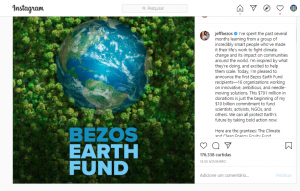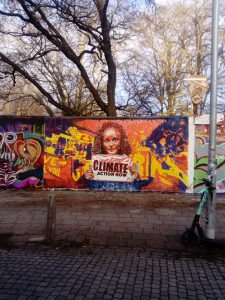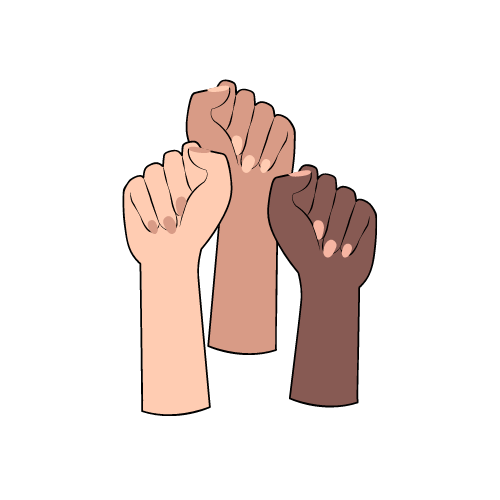November winds in Sweden brought me two good news, climate wise. First, I read the news that Jeff Bezos had finally announced the first beneficiaries of his climate fund. Second, I came across a beautiful mural of climate activist Vanessa Nakate, in the streets of Malmö. Since both individuals were subjects of my previous blog writings, I will take the opportunity and further analyze the potential meaning of these two events for climate activism on social media. I will also reflect and comment on the experience of writing for a development blog.
Bezos Earth Fund
On my first post, I made an association between Jeff Bezos’ (at the moment) unfulfilled climate pledge and major companies’ greenwashing of their image for popularity. Amazon, Google, Facebook, and others use vocabulary and release statements that create an image of environmental sustainability whiteout adopting the correct practices. It is unclear if Jeff Bezos now starting to fulfill his pledge is a result of the pressure put upon him by climate activists and journalists on social media. Perhaps it might be from a genuine concern of Bezos with the environment. The multimillionaire chose the social media platform Instagram to share the news of the first grantees (Bezos, 2020), planting in the mind of his 2.6 million followers the image of himself as an environmentally friendly businessman. The post, at the moment that this text was written, counted with 176.324 ‘likes’ and multiple comments, both praising his initiative and ironically mentioning that he can afford to grant more. This fact has also been supported by climate reporter Emily Atkin (Atkin, 2020).

Regardless of his motives, the donation is welcomed and certainly appreciated by the 16 beneficiaries and by our planet. Bezos’ visible climate action might lead to more companies, countries and individuals making climate pledges and sticking to them. Positive climate action, even when motivated by image aspirations, is what is most necessary.
Climate Action Now
The Ugandan climate activist Vanessa Nakate was a subject on my text with regards to the ‘whitewashing’ of climate activism by mainstream media. Despite the existence of climate activists of a variety of ethnicities and cultural backgrounds, prominence in media exposure is given to activists of white ethnicity. This jeopardizes global environmental efforts as it creates in masses a (false) notion that climate change is an issue that is being tackled by the global North and does not require contributions from the global South. By erasing BIPOC (Black, Indigenous, and People of Color) voices and faces from the mainstream debate, the media is doing a disservice to sustainability endeavors.

When writing about the transformative role of art, Maggie O’Neil (2008) describes art as a social product that not only reflects its social origins but is also constitutive in its nature. “Art makes visible experiences, hopes, ideas; it is a reflective space and socially it brings something new into the world—it contributes to knowledge and understanding.” (O’Neil, 2008). By that logic, the presence of a wide, colorful mural of a black climate activist holding a sign that demands “CLIMATE ACTION NOW” while surrounded by people in protest brings many ideas into the minds of passersby. Sweden is the birth country of the famous climate activist, Greta Thunberg. It is also a majority white society that constantly debates issues such as migration and the integration of minorities. The mural and its choice of Vanessa Nakate is a refreshing statement in a place that can at times be lacking in culturally and ethnically diverse leadership.
The mural is anonymous, there is no signature and the only words are a cry for action. It leaves space for multiple interpretations but the one I chose is that the artist recognizes that climate action can be led by women of color, and that it is urgent. The sight of it and its potential message made my day. The mural is an example of how the public takes it into its hands to build another image, one that is not preferred by the mainstream. It is also an example of how street art can be used to exert activism, by spreading a political message through graffiti. It is unsure how long the art work will stay in those walls but it has already marked the minds of those that came into contact with it.
Climate change, street art, and social media
Here, I would like to better analyze how the use of a picture of Vanessa Nakate as the subject of my text, and the whole attempt at writing a blog section focused on climate change is also a method of protest on social media. On their work, titled “Social media and new protest movements”, Thomas Poell and José van Dijck (2018) defend that social media enables bottom-up, distributed forms of mass protest and expose its three main arguments, which are as follows:
- New social movements, such as the one for climate protection, revolve around principles of solidarity and individuality among its participants.
- The communication process – through social media platforms – happens in such way that there is little need for formal leadership figures.
- Through social media, citizens have a wider range of political activities and ways of expression available to engage in.
Environmental action is not a new movement per se. What is new is the way in which new generations of environmental activists use communication mechanisms, specifically social media, to get their message across. The sense of urgency to save the planet is also relatively new, with the planet now reaching a scientific tipping point. In this movement, there is a sense of solidarity and togetherness that social media enhances in the sense that we can share and access information that concerns ‘our’ movement through it. It is possible still to maintain our individuality and own code of values and engagement since one can connect and disconnect oneself from the flow of climate related information. In this context, I consider myself a part of a wider community while still being conscious that I’m free to choose what to do and when to do it, which subjects to focus on and who to follow.
This brings us to the second point of Poell and van Dijck’s argument: leadership. The virtual space is notorious for giving a platform for whomever wants to express themselves. Some of these use their platform for promoting a cause that gathers many around them. They have ‘followers’ that keep track of the content they post, with whom they engage, and can serve as a motivating factor for activists around a certain topic. Poell and van Dijck (2018) call them connective leaders. “…connective leadership revolves around inviting, connecting, steering, and stimulating, rather than directing, commanding, and proclaiming.” In my quest for likeminded people, environment wise, I myself started ‘following’ different people on social media, with varying levels of influence. One way to see how many people can be potentially influenced by a user, is to check the number of followers. I.e. the number of accounts that keep track of content posted by the account followed, or in other words: how many people are brought together, connected and steered by one person. Vanessa Nakate, for example, as of the writing day of this text, has 182 thousand followers on Twitter, myself included. I pay attention to her recommendations, follow some accounts followed by her and take inspiration in her ideas. She is, to all effects, a leader, despite having no power no enforce anything on me or others. I can also unfollow her and others in two clicks thus ending their influence over me. The only attachment – if it can so be called – I have to Nakate is our common care for the planet.
As for the third point of Poell and van Dijck’s argument, regarding the range of political activities. It is the ultimate question. “What can I do to make a change?” Environmental protection being one of my political causes, what action can I take to feel that I am leaving my mark on the subject. There already exists a wide range of options for people that are environmentally conscious and the the virtual space has served to further broaden them. One can find a virtual community and be inspired by what they are doing. Blogging is a way to not only express ones’ views and share them with others. It is also an activity that gives the sense of having taken action and is very versatile since there exist many platforms for such.
This to say that my personal experience as a climate activist that uses social media as a tool of protest is an example of Poell and van Dijck’s argument. In the same way, my choice to discuss the picture of a graffiti on my final text is a conscious decision and statement made possible by the flexibility of formats that social media, as a communication medium for protestors and non-protestors, allows.
Blogging
In her book titled “Blogging”, Jill Walter Rettberg (2014) states that there are 3 main styles of blogging: 1. Personal/diary style blogging; 2. Filter blogging; and 3. Topic driven blogging. Personal/diary style blogging refers to the style in which the blogger’s live is the primary subject of the blog’s content. On my personal microblogging profile (Twitter), I have done what Rettberg describes as ‘filter blogging’, by recording my experiences and findings on the Web. There (on Twitter), I use a style and format that are already determined by the creators of the server, just as the other users. This here blog is an attempt at a ‘topic driven blogging’ style. It is a blog with multiple editors but the section written by me is centered on environment and media related topics. As per Ruttberg’s (2014) description, I “share newly discovered ideas and information” with my readers and also provide “links to more information”.
Blogging on this format is not an untried experience for me. I have another topic-centered blog, that runs on a different server. In this time of digital media, blogs are not as complicated to put up and run as they once were. What is new is the experience of collaborative writing, the focus on climate, social media and development. Also, the structure necessary to ensure that the blog maintains a certain standard and fulfills certain requirements. Rettberg (2014) mentions Evan William’s “Blogging Trinity”, which is constituted by frequency, personality and brevity of posts. Good bloggers have mastered the Trinity and enjoy different kinds of success and readership from their efforts and craftsmanship. As for my part, I have yet to achieve said Trinity. Nevertheless, the endeavor has been a very beneficial learning process and it is also inspiring in many ways.
Choosing which topics to approach, finding the right voice in which to address audiences, finding the balance between my passions and the public’s interests, commenting to a publishing schedule, navigating the seeming infinite sources on the Web… these and more were some of the steps necessary for me to take, the skills required to learn. It is different from academic writing on many angles. The brevity of posts and the possibility to keep an informal, personal voice/style of writing are my favorite characteristics. The need to maintain a schedule was my main struggle. It has taught me that, in some cases, ‘done is better than perfect’. Overall, the experience was highly beneficial and also entertaining. The blogs maintained by my fellow Communication for Development students were rich in content and ideas, graphics and discussion. A sample of the rich minds behind the screen.
To Wrap It Up
Climate Action is Sustainable Development Goal (SDG) number 13 but human kind’s livelihood and hope for a better future revolve around the existence of healthy ecosystems. That is a fact of which millions around the world agree on, work and fight for. It is necessary to gather more people around this goal and an effective way that activists have found to do so is through social media. In my four previous texts I have written about how this media can be manipulated for image promotion, how it discriminates BIPOC and effects climate justice, how misinformation and disinformation hinder efforts to inform people. I have also used this space to, hopefully inform and raise awareness, to share ideas and opinions and leave my mark on an issue that I am passionate about. It is living proof that activism can happen on the virtual world, as well as on the physical one and that blogging is a valid medium to expand our networks.

Sources
Atkin, E. (2020, November 17). Bezos, et cetera. Heated. https://heated.world/p/bezos-et-cetera
Bezos, J. (2020, November 16). https://www.instagram.com/p/CHpwxnvHufz/
O’Neill, M. (2008). Transnational Refugees: The Transformative Role of Art?. Forum Qualitative Sozialforschung / Forum: Qualitative Social Research, 9(2). doi:http://dx.doi.org/10.17169/fqs-9.2.403
Rettberg, J.W. (2014). Blogging (2nd ed.). Polity.
Poell, T. & José van Dijck (2018). Social Media and new protest movements. In The SAGE Handbook of Social Media, 546-561, edited by Jean Burgess, Alice Marwick & Thomas Poell. London: Sage.

